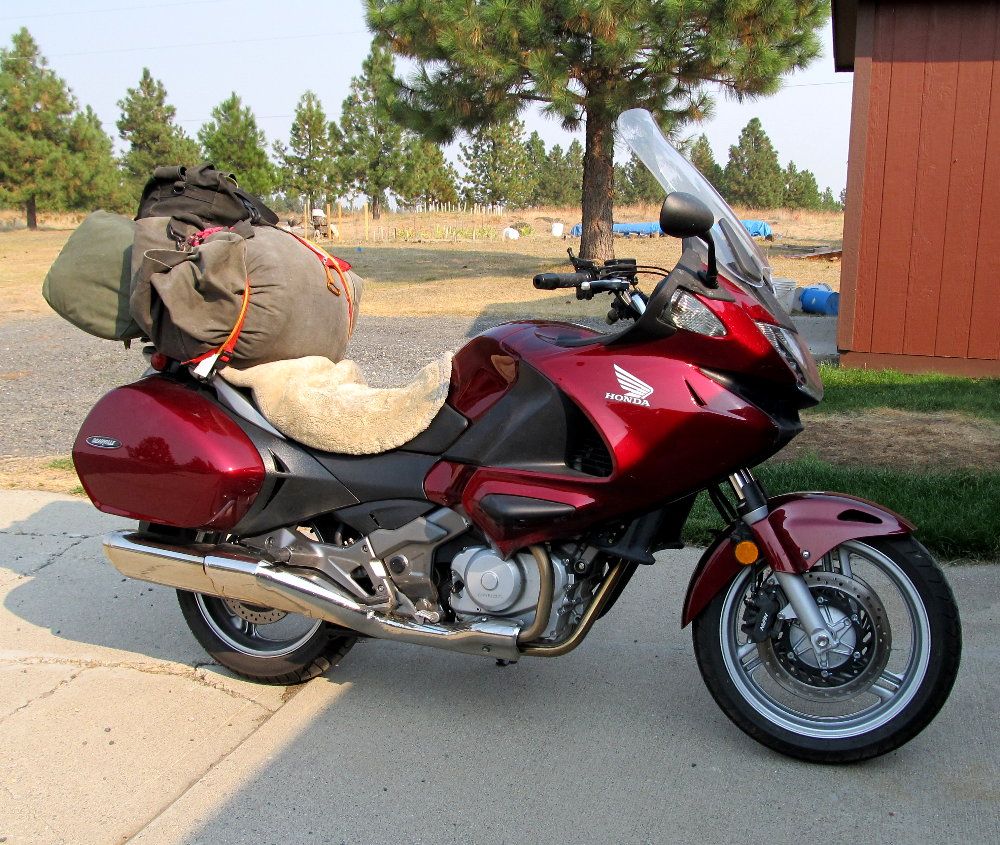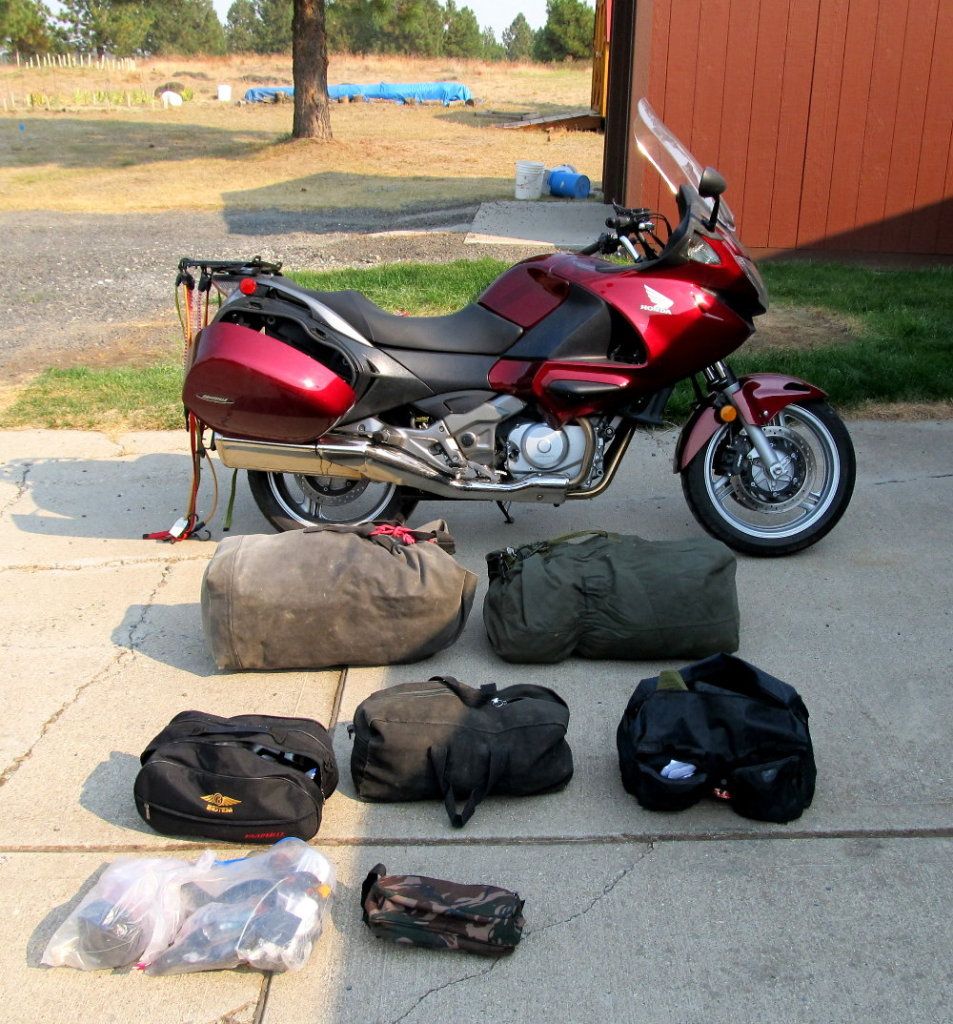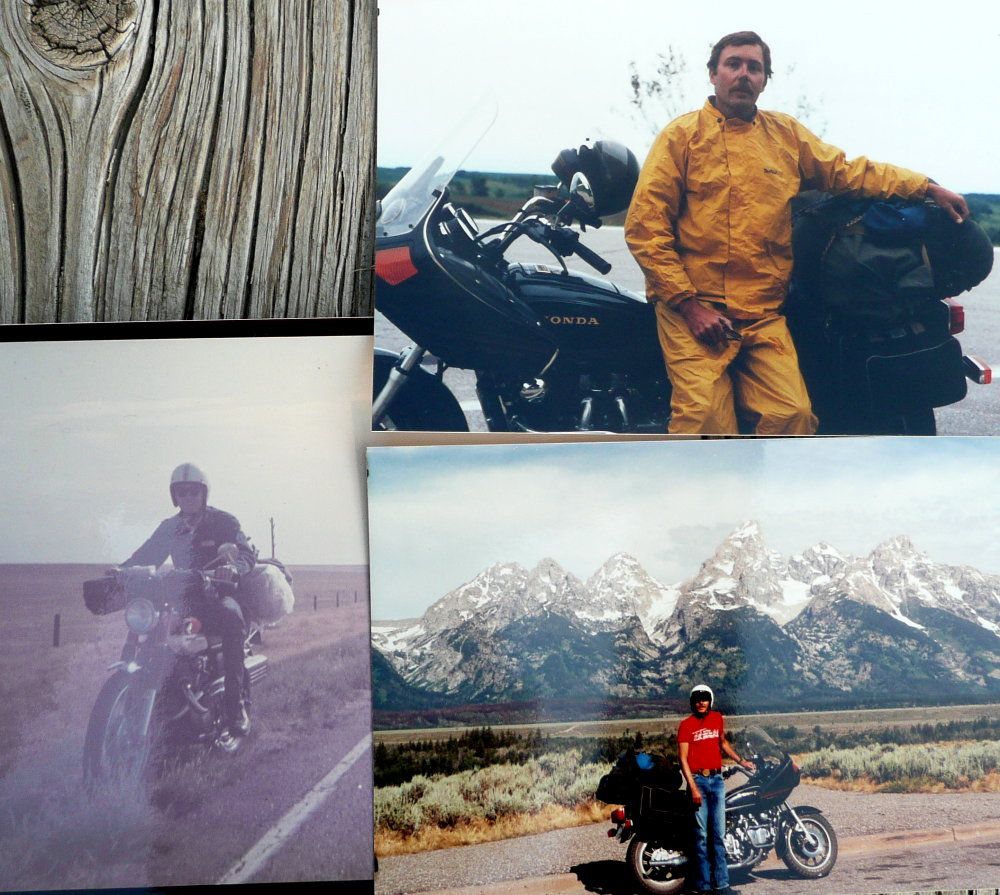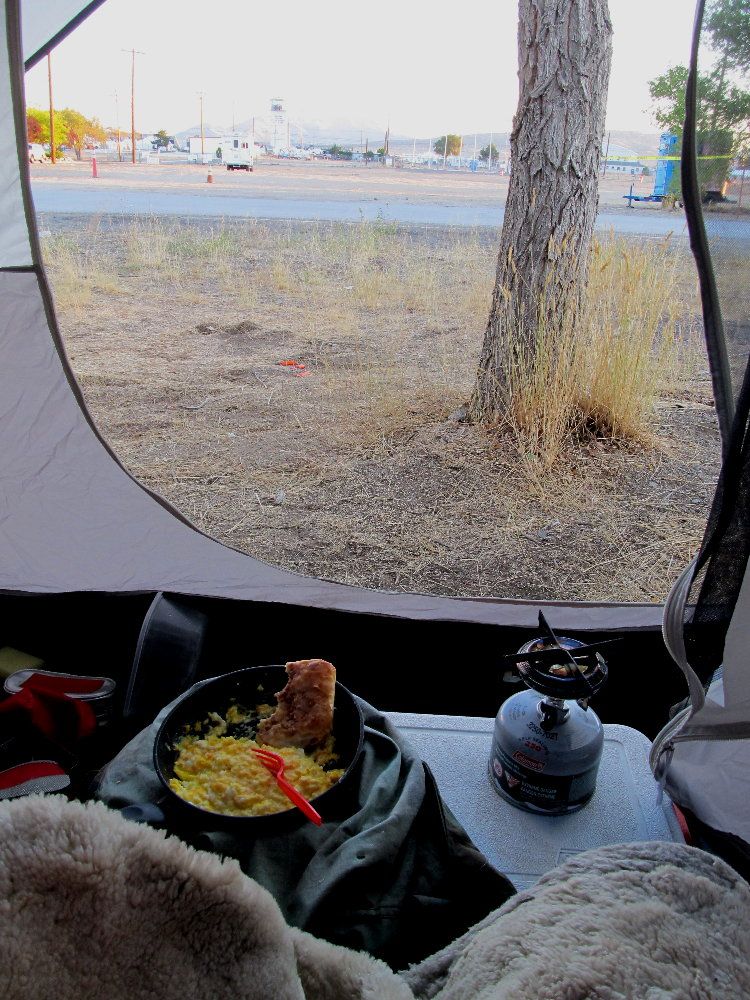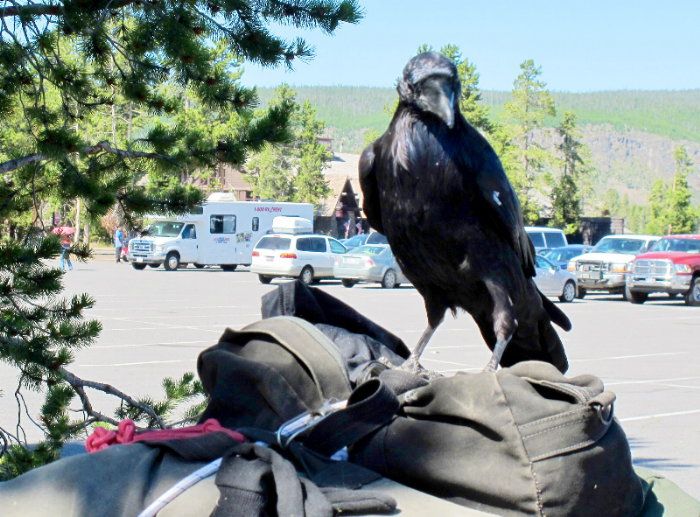Mellow
Admin
Edit: I posted this originally on NT-Owners.org and thought I'd post here as well.
People are always asking me why I like camping so much and how I can camp on the bike, what are the tips and tricks to it?
Well, everyone is different and I can only provide the tricks that I've learned in the past few years that work for me.
Remember, these are only MY personal preferences and can be used as a starting point for you to get into camping on a motorcycle,
don't be afraid to change things that you feel will work for YOU.
My Background:
I only started riding since Dec 1999 and my camping experience on the bike only began in 2002 so roughly 10 years.
I've developed my camping techniques over these past 10 years and camped on Goldwings, ST1300s and now Dual Sports - Super Tenere/VStrom.
What is the bare minimum I need to camp?
This is the 1 million dollar question. Well here ya go:
1 - A tent
2 - A sleeping bag
3 - An air mattress
4 - Waterproof bag(s)
5 - Pillow - inflatable or compressible
6 - Flashlight and/or Headlamp - preferably LED for long life
That's it. Simple as that.
Now, I'll expand on the items listed above a bit then talk about some alternatives that some prefer.
The Tent:
Cost
Single or Double Walled?
Seasons
Accessories
Size
Packed Size
The Sleeping Bag
This is a tough one. Some of this will be dictated by the air mattress you end up getting. If the mattress has little or no insulation properties
then you may need a better sleeping bag. For me, a 20-40 degree bag is good enough for just about every temperature range you'll see on
your typical motorcycle touring adventure.
Type
Rectangle - These are pretty much what most people think about when they think sleeping bags. These provide the most shoulder room and area to move around.
Mummy - These bags are great for cold weather as they allow you to tuck your head into the top section and they are tapered at the leg/feet
section. This allows your body heat to warm up a minimal amount of area while also keeping your head covered. When sleeping in one of these
you will have everything covered except for your nose/mouth area. Seems kinda strange at first but it works very well. You also don't want your
mouth covered as the vapors you exhale will collect in the bag and make it damp.
There are some bags on the market now that offer a rectangular shaped bag but a zip-off top shaped like a mummy.
Down or Synthetic - the major advantage of a down bag is it will pack to a smaller size than a synthetic bag. The major advantage of a synthetic bag
The Air Mattress
The Bags
What about cooking
Useful Links:
Sleeping Bags
Air Mattresses
Waterproof Bags
Pillow
Conclusion
I hope I've provided enough information based on my 10+ years of camping to make your choices for camping a little less painful. There are many out
there that have camped much longer than I have and in more extreme environments than I have so I am far from an expert. I can only add that the
techniques I describe above in picking my gear has worked very well for me and sometimes I feel more comfortable in my tent than I do at home in my
bed. The whole point is to try and take the pain out of picking gear as there are so many options it's overwhelming at times. This may not work for
everyone but does for me.
Please post any comments and I'll do my best to address them.
People are always asking me why I like camping so much and how I can camp on the bike, what are the tips and tricks to it?
Well, everyone is different and I can only provide the tricks that I've learned in the past few years that work for me.
Remember, these are only MY personal preferences and can be used as a starting point for you to get into camping on a motorcycle,
don't be afraid to change things that you feel will work for YOU.
My Background:
I only started riding since Dec 1999 and my camping experience on the bike only began in 2002 so roughly 10 years.
I've developed my camping techniques over these past 10 years and camped on Goldwings, ST1300s and now Dual Sports - Super Tenere/VStrom.
What is the bare minimum I need to camp?
This is the 1 million dollar question. Well here ya go:
1 - A tent
2 - A sleeping bag
3 - An air mattress
4 - Waterproof bag(s)
5 - Pillow - inflatable or compressible
6 - Flashlight and/or Headlamp - preferably LED for long life
That's it. Simple as that.
Now, I'll expand on the items listed above a bit then talk about some alternatives that some prefer.
The Tent:
Cost
If you're only planning on camping a few times a year you can probably get by with a low-cost tent in the range of $100 or less. But, if you plan
on doing a lot of camping then it may be beneficial to splurge for some name-brand equipment which may run in the $150+ range.
Type
Tents come in several types but we will only discuss a couple here.
on doing a lot of camping then it may be beneficial to splurge for some name-brand equipment which may run in the $150+ range.
Type
Tents come in several types but we will only discuss a couple here.
Bivy - These are typically one-person tents that have one or more poles that require being staked out with tent stakes in order to
retain their shape/structure.
Dome - A dome tent is typically a stand-alone tent where, once the tent poles are installed, will stand up on it's own without needing
to be staked out. For me, THIS is the preferred type of tent for camping on a motorcycle.
Many dome tents are configured with a front entry
door or a side entry door. I find the side doors to be the easiest to crawl into/out of.
Some of these tents also provide the option of 1 or 2
vestibules - the area the rain fly covers that is not inside the tent. This allows for good additional storage space for those things you don't
want or need inside the tent.
retain their shape/structure.
Dome - A dome tent is typically a stand-alone tent where, once the tent poles are installed, will stand up on it's own without needing
to be staked out. For me, THIS is the preferred type of tent for camping on a motorcycle.
Many dome tents are configured with a front entry
door or a side entry door. I find the side doors to be the easiest to crawl into/out of.
Some of these tents also provide the option of 1 or 2
vestibules - the area the rain fly covers that is not inside the tent. This allows for good additional storage space for those things you don't
want or need inside the tent.
Single or Double Walled?
A single-walled tent incorporates the tent and rain fly into one. While this seems like a great approach it can be the source of condensation inside
the tent. I prefer to stay away from this for motorcycle camping.
A double-walled tent is simply a tent which has a separate rain fly. The tent will have some mesh to allow for ventilation and the rain fly, once set up,
will not tough the inner tent. When it rains, the fly will divert the rain away from the tent.
the tent. I prefer to stay away from this for motorcycle camping.
A double-walled tent is simply a tent which has a separate rain fly. The tent will have some mesh to allow for ventilation and the rain fly, once set up,
will not tough the inner tent. When it rains, the fly will divert the rain away from the tent.
Seasons
A 3-season tent is more than adequate for camping on a motorcycle. 4-Season tents are made for those thinking of camping in some
pretty harsh environments including deep snow. If the weather or camping conditions are going to be that bad, you probably decided
to stay home.
pretty harsh environments including deep snow. If the weather or camping conditions are going to be that bad, you probably decided
to stay home.
Accessories
Attic - An attic is some mesh material hanging from the top section of the inside of the tent. This is useful for placing lights, glasses, phones or whatever you find you want to keep off the floor of the tent. This is a very nice thing to have. Not all tents come with these and some will be
included at extra cost.
Footprint - Some believe a tent footprint are used to keep water out of a tent, however they are really only used to help protect the bottom
of a tent from punctures or abrasions which would compromise the waterproof 'bathtub' design of the tent. Some tents will include a footprint
and some are provided at extra cost but even a simple cheap tarp will provide as much protection.
included at extra cost.
Footprint - Some believe a tent footprint are used to keep water out of a tent, however they are really only used to help protect the bottom
of a tent from punctures or abrasions which would compromise the waterproof 'bathtub' design of the tent. Some tents will include a footprint
and some are provided at extra cost but even a simple cheap tarp will provide as much protection.
Size
I always get a 2-person tent if there's only one person that will be camping the tent. This provides some extra space for gear, luggage or other
items. Two people camping = 3-person tent.
items. Two people camping = 3-person tent.
Packed Size
I also always pay attention to the packed size specification for the tent. The long dimensions typically tell you how long the tent pole sections
are. A tent stating a packed size of 24x7 usually means 2' tent pole sections and that makes it a bit tough to pack on a bike. A I personally try
to find packed sizes in the 18" range as I can then pack the tent poles just about anywhere on the bike.
A little tip here. If you look at backpacking or hiking equipment you'll find things that were designed to be smaller than the family-camping
equipment where weight and size are of little concern.
A little tip here. If you look at backpacking or hiking equipment you'll find things that were designed to be smaller than the family-camping
equipment where weight and size are of little concern.
The Sleeping Bag
How Cold
This is a tough one. Some of this will be dictated by the air mattress you end up getting. If the mattress has little or no insulation properties
then you may need a better sleeping bag. For me, a 20-40 degree bag is good enough for just about every temperature range you'll see on
your typical motorcycle touring adventure.
Type
Rectangle - These are pretty much what most people think about when they think sleeping bags. These provide the most shoulder room and area to move around.
Mummy - These bags are great for cold weather as they allow you to tuck your head into the top section and they are tapered at the leg/feet
section. This allows your body heat to warm up a minimal amount of area while also keeping your head covered. When sleeping in one of these
you will have everything covered except for your nose/mouth area. Seems kinda strange at first but it works very well. You also don't want your
mouth covered as the vapors you exhale will collect in the bag and make it damp.
There are some bags on the market now that offer a rectangular shaped bag but a zip-off top shaped like a mummy.
Down or Synthetic - the major advantage of a down bag is it will pack to a smaller size than a synthetic bag. The major advantage of a synthetic bag
is it will dry out faster if it gets wet. Since packing size is my major concern I will typically go for a down sleeping bag.
The Air Mattress
Most don't think about air mattresses much when they think about camping, the tent and sleeping bag seem to get all the initial concern but the air
mattress can be the most important part of all the gear.
Remember, if you don't get a good night's sleep then you won't be 100% the next day when you get on the bike on public roads.
When you lay on an air mattress there are 2 things happening. One is your body is trying to warm the air inside the mattress and the other thing is the
ground is trying to cool the air in the mattress. If the mattress has low or no insulating properties then your body is fighting a loosing battle with the
ground.
Some purchase very thick air mattresses with no insulation because they think it will be more comfortable but anything above 4 inches thick is just about
impossible to warm with your body in cooler temps. Air mattresses in the 2 to 4 inch thick range but also with some type of internal insulation will provide
the best night's sleep.
The width of the air mattress is also an issue, many are 20 inches wide, seems wide enough but you want something at least 24 inches wide or you will
be rolling off the mattress.
With the thicker mattresses, I find it best to not inflate them 100% but more about 75%. That will mean less air to warm up but also you lay IN the
mattress and seems to make them more comfortable.
mattress can be the most important part of all the gear.
Remember, if you don't get a good night's sleep then you won't be 100% the next day when you get on the bike on public roads.
When you lay on an air mattress there are 2 things happening. One is your body is trying to warm the air inside the mattress and the other thing is the
ground is trying to cool the air in the mattress. If the mattress has low or no insulating properties then your body is fighting a loosing battle with the
ground.
Some purchase very thick air mattresses with no insulation because they think it will be more comfortable but anything above 4 inches thick is just about
impossible to warm with your body in cooler temps. Air mattresses in the 2 to 4 inch thick range but also with some type of internal insulation will provide
the best night's sleep.
The width of the air mattress is also an issue, many are 20 inches wide, seems wide enough but you want something at least 24 inches wide or you will
be rolling off the mattress.
With the thicker mattresses, I find it best to not inflate them 100% but more about 75%. That will mean less air to warm up but also you lay IN the
mattress and seems to make them more comfortable.
The Bags
I like to keep the things I use for sleeping in a waterproof bag and the tent in a separate waterproof bag. This works well for a couple reasons. First, it
keeps your wet tent away from the stuff you want dry and inside your tent. Second, it allows you to begin packing up your campsite while you're still
inside your tent. Wake up and pack your air mattress and sleeping bag into one waterproof bag while inside your tent and even if it's raining, you've
accomplished to keep your dry stuff dry and you're half done with packing.
There are many waterproof bags on the market from $40 to well into the $100 range. You pretty much just need to search for 'dry bags' and you'll
come up with many options. Try to find a bag that meets the min packed size of your tent unless you plan on storing the tent poles elsewhere.
keeps your wet tent away from the stuff you want dry and inside your tent. Second, it allows you to begin packing up your campsite while you're still
inside your tent. Wake up and pack your air mattress and sleeping bag into one waterproof bag while inside your tent and even if it's raining, you've
accomplished to keep your dry stuff dry and you're half done with packing.
There are many waterproof bags on the market from $40 to well into the $100 range. You pretty much just need to search for 'dry bags' and you'll
come up with many options. Try to find a bag that meets the min packed size of your tent unless you plan on storing the tent poles elsewhere.
What about cooking
I try to keep things simple. I have previously packed a backpacking stove and fuel so I can boil water for coffee/hot chocolate or warm up some food
however I find it's too much of a hassle. It's something you need to decide how important it is to you. The purpose of this thread is to show you
the bare minimum you need to camp on a motorcycle and be comfortable. There are many that will say what I bring is not the bare minimal and there
are those that will bring a lot more gear including stoves, fuel and food.
I feel that I'm almost always close enough to a town to eat before getting to a campground or head into town in the morning if I feel I want coffee and/or
breakfast. So for me packing the extras needed for cooking are not that important.
however I find it's too much of a hassle. It's something you need to decide how important it is to you. The purpose of this thread is to show you
the bare minimum you need to camp on a motorcycle and be comfortable. There are many that will say what I bring is not the bare minimal and there
are those that will bring a lot more gear including stoves, fuel and food.
I feel that I'm almost always close enough to a town to eat before getting to a campground or head into town in the morning if I feel I want coffee and/or
breakfast. So for me packing the extras needed for cooking are not that important.
Useful Links:
Below I have some links to gear that I either have or have used and I feel meet the requirements of what I've posted above:
Tents
Tents
Sleeping Bags
Air Mattresses
Waterproof Bags
Pillow
Conclusion
I hope I've provided enough information based on my 10+ years of camping to make your choices for camping a little less painful. There are many out
there that have camped much longer than I have and in more extreme environments than I have so I am far from an expert. I can only add that the
techniques I describe above in picking my gear has worked very well for me and sometimes I feel more comfortable in my tent than I do at home in my
bed. The whole point is to try and take the pain out of picking gear as there are so many options it's overwhelming at times. This may not work for
everyone but does for me.
Please post any comments and I'll do my best to address them.

